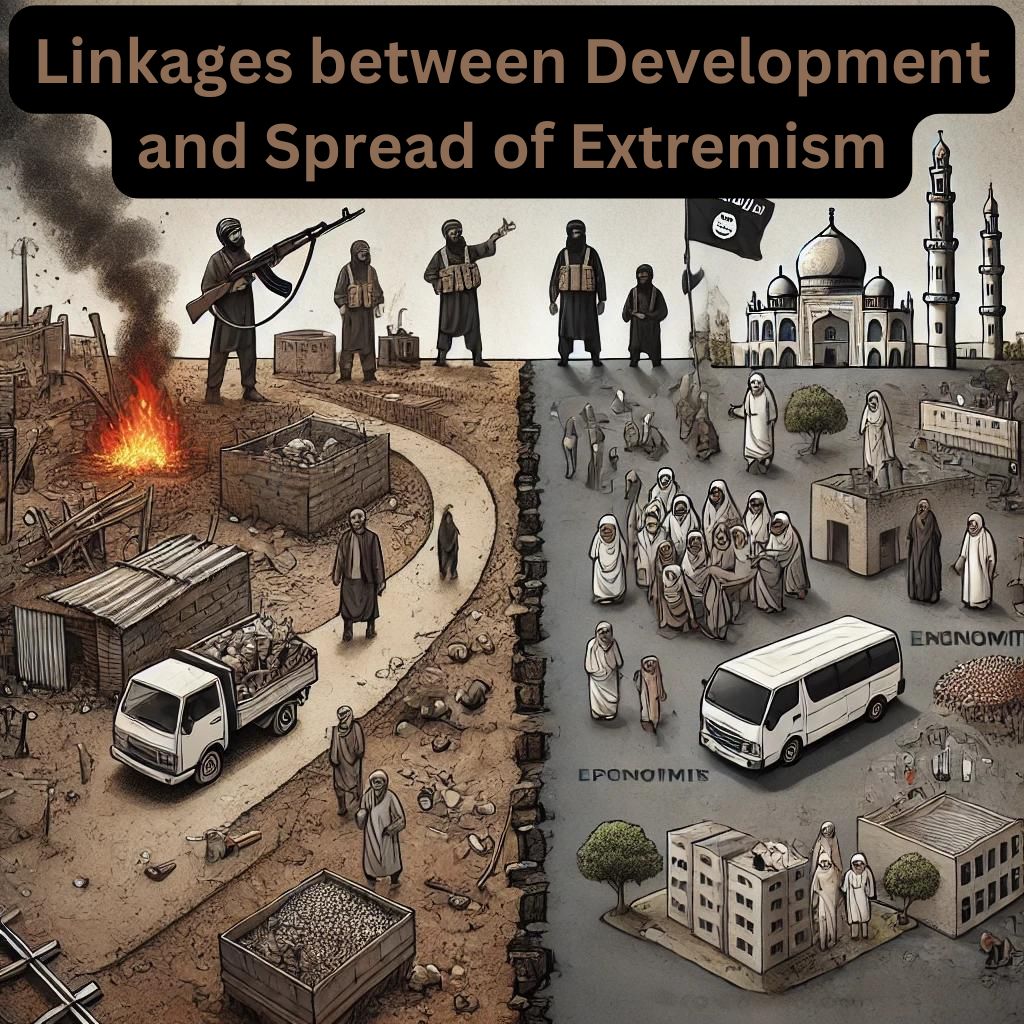The linkages between development and spread of extremism are interconnected, as underdeveloped regions often become breeding grounds for extremist ideologies. Extremism typically finds fertile ground in areas where people face chronic poverty, unemployment, and a lack of access to basic services like education and healthcare. These conditions create a sense of frustration, anger, and hopelessness among the local population. They make them lean towards radical ideologies that promise change and empowerment. In such environments, extremist groups can easily recruit members by exploiting grievances and promising a better future through violent means.
The connection between underdevelopment and extremism is not just a theoretical concept but a reality observed in various parts of the world. Several regions in India, clearly demonstrate how underdevelopment and poor governance contribute to the spread of extremism.
- Lack of educational opportunities leaves the youth vulnerable to radicalization.
- The inequitable distribution of resources creates resentment and drives people toward extremist ideologies.
- Areas marginalized by the government often witness a rise in extremist activities.
- Discrimination and exclusion of certain communities create conditions ripe for extremism to thrive.
- Corruption and ineffective governance undermine development efforts, worsening the situation.
Addressing the linkages between development and spread of extremism is crucial for creating a stable and peaceful society. It requires a complex approach that includes not only development but also social inclusion, political reform, and effective governance. Without these efforts, development alone cannot prevent the rise of extremism.
| GS Paper | General Studies Paper III |
| Topics for UPSC Prelims | Causes of extremism, Development disparities, Impact of underdevelopment |
| Topics for UPSC Mains | Link between development and extremism, Policy responses |
Underdevelopment and Left-Wing Extremism
Left-wing extremism, often referred to as Maoism, is one of the most significant challenges in India, particularly in the central and eastern regions. The linkages between development and spread of extremism are naturally visible here. These areas are rich in natural resources. But they suffer from severe underdevelopment, with poor infrastructure, lack of employment opportunities, and inadequate access to basic services like education and healthcare. The exploitation of local resources by external entities without benefiting the local population has led to widespread resentment and anger.
| Factors Contributing to Left-Wing Extremism | |
| Land disputes | Many tribal communities have been displaced due to mining and industrial projects, fueling anger and extremism. |
| Lack of basic amenities | The absence of roads, electricity, and healthcare services in remote areas has led to a feeling of neglect. |
| Exploitation of resources | The extraction of natural resources without benefiting the local population has created a sense of injustice. |
| Unemployment | High unemployment rates among the youth make them easy targets for recruitment by extremist groups. |
Addressing these issues is critical to breaking the linkages between development and spread of extremism in these regions. Development initiatives must focus on ensuring that local communities benefit from the resources in their areas. They should provide them with employment opportunities, and improve access to education and healthcare.

Insurgency in Northeast India
The insurgency in Northeast India is another example of how the linkages between development and spread of extremism manifest. The region, characterized by ethnic diversity and geographical isolation, has long suffered from neglect in terms of development. The feeling of alienation, coupled with a lack of infrastructure, has given rise to various insurgent movements. These movements are often a response to perceived injustices and the absence of development.
Some Examples of Linkages Between Development and Extremism in India
- Jharkhand: The lack of access to education and healthcare has fueled left-wing extremism in the state.
- Assam: Underdevelopment and ethnic tensions have led to insurgent movements, particularly among marginalized communities.
- Chhattisgarh: Displacement due to mining projects has strengthened the linkages between development and spread of extremism.
- Manipur: The absence of infrastructure and economic opportunities has perpetuated insurgent activities in the region.
- Bihar: Poverty and unemployment have driven youths toward extremist groups, seeking better prospects through radical means.
Relation Between Development and Extremism
The relationship between development and extremism is complex, as underdevelopment often creates conditions favorable to the rise of extremist movements. In areas where the government has failed to provide basic services, extremist groups step in to fill the void, providing education, healthcare, and even governance. It creates a situation where the local population begins to rely on these groups for their basic needs. It further strengthens the linkages between development and spread of extremism.
Extremist groups exploit the lack of development by:
- Providing basic services: In the absence of government services, extremist groups provide education and healthcare, gaining the support of the local population.
- Offering protection: In areas where law and order are weak, extremist groups offer protection, further consolidating their power.
- Promoting alternative governance: Extremist groups often establish parallel systems of governance in underdeveloped areas, challenging the authority of the state.
- Exploiting grievances: By highlighting the government’s failure to deliver development, extremist groups gain support by promising to address these grievances.
Breaking the linkages between development and spread of extremism requires a concerted effort to improve governance, ensure the fair distribution of resources, and involve local communities in decision-making processes. Development projects must be inclusive, targeting the most vulnerable sections of society to weaken the appeal of extremist ideologies.

Counter Actions Against Extremism
Counter-actions against extremism must go beyond military and police operations to address the underlying causes of extremism. The linkages between development and spread of extremism can only be broken by addressing the root causes, such as poverty, unemployment, social exclusion, and weak governance. Development initiatives must be designed to be inclusive, ensuring that all sections of society benefit from them.
| Effective Interactions | |
| Improving governance | Strengthening local governance structures and reducing corruption are essential to winning the trust of the local population. |
| Promoting inclusive development | Development projects must focus on including marginalized communities to prevent them from turning to extremist ideologies. |
| Ensuring access to basic services | Improving access to education, healthcare, and employment opportunities can reduce the appeal of extremist groups. |
| Involving local communities | Engaging local communities in decision-making processes ensures that development initiatives address their specific needs and concerns. |
Linkages Between Development and Spread of Extremism: Current Situation
The current situation regarding the linkages between development and spread of extremism shows a mixed picture. While some regions have seen a decline in extremism due to successful development initiatives, others continue to struggle with violence and underdevelopment. The uneven distribution of development across the country means that certain areas remain vulnerable to extremist ideologies.
In regions where development has been inclusive and participatory, the linkages between development and spread of extremism have weakened, leading to a reduction in violence. However, in areas where development remains uneven, extremism continues to be a significant challenge. It highlights the importance of sustained and fair development efforts to counter extremism effectively.
Government Initiatives for Regions Affected by Extremism
The Indian government has implemented several initiatives to address the linkages between development and spread of extremism in regions affected by violence. Programs like the Integrated Action Plan (IAP) for Maoist-affected areas focus on improving infrastructure, education, and healthcare. These initiatives aim to ensure that development reaches the grassroots level. They address the grievances of the local population and reduce the appeal of extremist ideologies.
| Government Initiatives | |
| Integrated Action Plan (IAP) | Focuses on infrastructure development in Maoist-affected areas, including roads, schools, and healthcare facilities. |
| Skill development programs | Aim to provide employment opportunities to the youth in insurgency-affected regions, reducing their vulnerability to extremist recruitment. |
| Special infrastructure schemes | Target the development of basic amenities in remote and underdeveloped regions to address the root causes of extremism. |
| Inclusive governance | Efforts to involve local communities in the decision-making process to ensure that development initiatives address their specific needs. |

Decline of Extremism
The decline of extremism in certain regions of India can be directly linked to successful development initiatives. When people see tangible improvements in their lives, such as better roads, schools, and healthcare, the linkages between development and spread of extremism weaken. Development improves living standards and fosters a sense of inclusion and belonging, reducing the allure of extremist movements.
| Successful Examples | |
| Andhra Pradesh | The state witnessed a decline in left-wing extremism due to targeted development initiatives that focused on infrastructure and employment generation. |
| Kerala | The state’s emphasis on education and healthcare has prevented the spread of extremism, even in underdeveloped regions. |
| Punjab | Economic growth and improved governance have contributed to the decline of extremist movements in the state. |
These examples demonstrate that development should be implemented effectively and inclusively. They can significantly weaken the linkages between development and spread of extremism.
Measures to Address the Root Causes of Violent Movements
Addressing the root causes of violent movements is essential to breaking the linkages between development and spread of extremism. It requires a comprehensive approach that goes beyond economic development to include social justice, political inclusion, and respect for human rights. Empowering local communities, and fostering dialogue between the government and marginalized groups are necessary steps to create a stable and peaceful society.
Key measures include:
- Ensuring social justice: Addressing grievances related to land rights, discrimination, and social exclusion can reduce the appeal of extremist ideologies.
- Promoting political inclusion: Ensuring fair political representation for marginalized communities can prevent the rise of extremist movements.
- Respecting human rights: Protecting the rights of all citizens, including those in underdeveloped regions, is essential to building trust in the government.
- Fostering dialogue: Encouraging dialogue between the government and extremist groups can lead to peaceful resolutions and reduce violence.
Conclusion
The linkages between development and spread of extremism are undeniable and complex. Addressing these linkages requires a holistic approach that goes beyond mere economic development. It involves creating a just and inclusive society where every citizen feels valued and has access to basic services. The fight against extremism is not just about countering violence but about building a society where extremism has no place to grow. It can only be achieved through sustained and inclusive development efforts that address the root causes of extremism. It ensures that all sections of society benefit from the country’s progress.
| Linkages Between Development and Spread of Extremism UPSC Notes |
| 1. Extremism often thrives in underdeveloped regions where poverty, unemployment, and lack of basic services create fertile ground for radical ideologies. 2. Left-wing extremism in India is deeply rooted in areas with severe underdevelopment, poor infrastructure, and exploitation of natural resources without local benefits. 3. Insurgency in Northeast India is fueled by ethnic tensions, geographical isolation, and a lack of infrastructure, leading to alienation and resentment. 4. Extremist groups exploit the absence of government services by providing basic needs like education and healthcare, strengthening their influence in underdeveloped areas. 5. Successful development initiatives, such as improving infrastructure and providing employment, can weaken extremism by addressing root causes like poverty and exclusion. |



